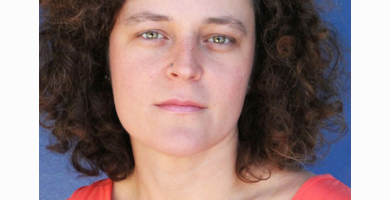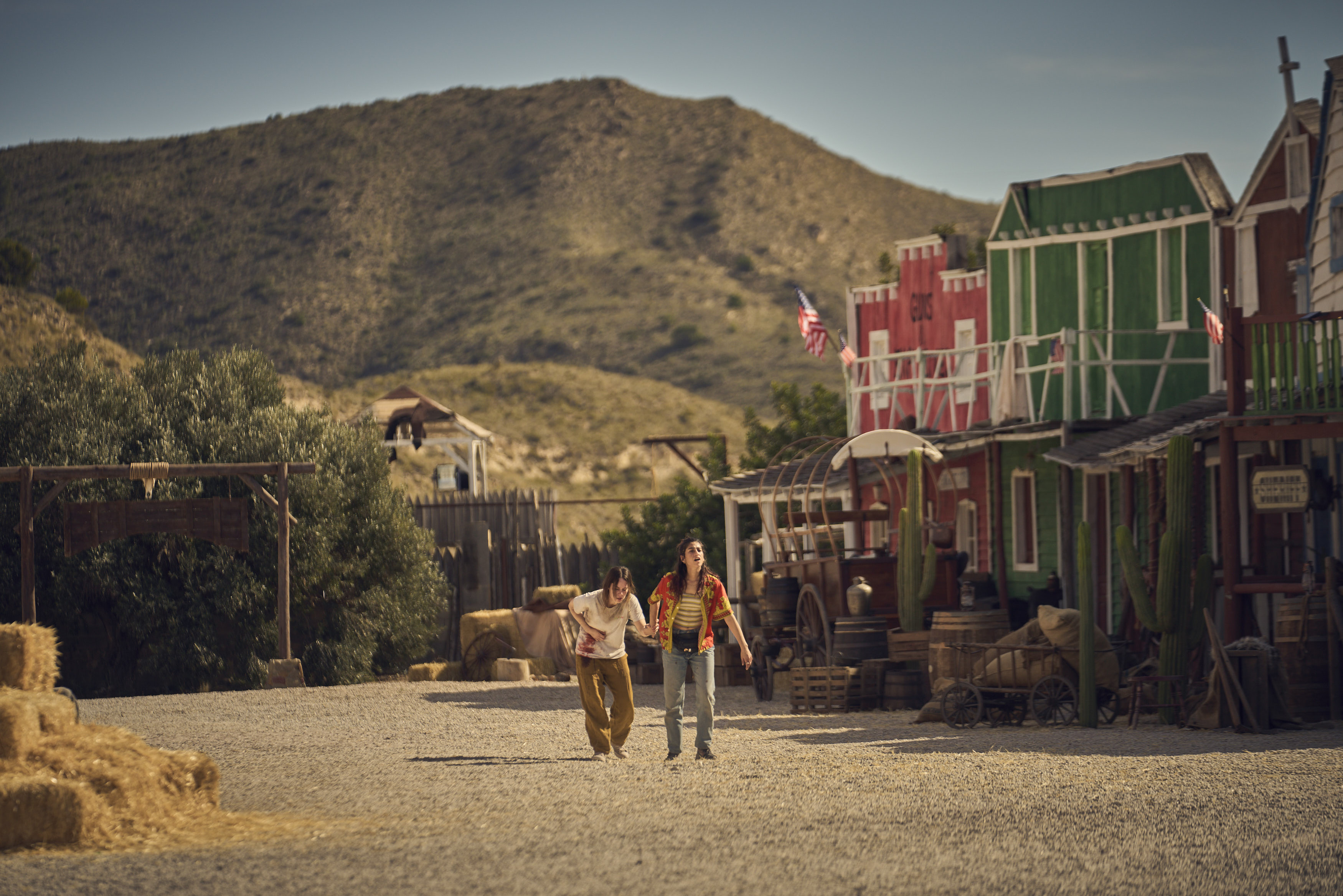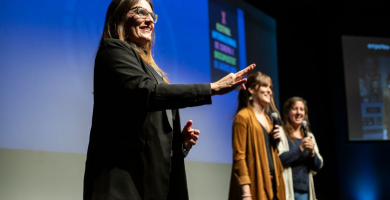
NINA CAUSSA: “The Production Designer imagines and creates the whole world or universe where the story takes place.”
This month we interviewed Nina Caussa, a production designer who has worked on several films shot in Barcelona, such as Desmontando un elefante, No Traces, Pájaros and Esmorza amb mi. We talked with her about her profession.

For those who don’t know what it is, what does production design consist of?
Production design, which is often also called art direction - and here the terms are confused - is the person responsible for the art department and who imagines and creates the whole world or universe where the story takes place. Whether it’s created starting from locations which already exist, scenery is built on the set or there is a combination with digital effects. The production designer is also part of this because, in essence, it will be on screen. It is moreover from the more general to the smallest space. What decorates this space, what furniture, what plants, what vehicles there are, what props the characters use. It covers a bit of everything that is visual and that is not costumes and how it’s illuminated.
How did you come to production design? What attracted you to this aspect of audiovisual?
I entered the ESCAC film school thinking I wanted to write scripts. The truth is I hardly knew that production design existed. My knowledge of the world of film was much more amateur. And I was hardly aware of what production design and art direction were. When I started at ESCAC, this seemed more what I liked doing than scriptwriting. I was a fairly visual person. I’d always drawn, I made things with my hands, ... And I thought that this was much closer to my interests. So, starting from the third year, when we were already doing a specialization, I went in for this. Despite the fact that, afterwards, the truth is that where I learnt the most was working and on a master’s degree that I did later on in stage design, but it helped me.
When you begin a new project, do you have a specific way of tackling it?
Each project may request different things. Normally, with a film or a series for which you’re creating a space for a story, I begin with the script or with the nearest thing that there is in the script. Reading it and seeing a little what space and what world this story needs, how I see it in the text and how the person who created this story sees it: the scriptwriter, the director or, sometimes, it comes more from a creative production. I sort of start with this conversation on what we think the world where this story takes place is like.
You also work on other audiovisual media apart from film. Does your work as a production designer change a lot in a film rather than an advert, a television series or a video clip? Is the creative process different?
In general, the design of spaces for stories will also include theatre or even theme parks; it has something at the centre which is shared and then there are small variations. You can move from one medium to another and then you’ll have to see the details. You have to know that, in advertising, for a start everything goes much quicker, they are shorter and there’s a product or an idea that they want to sell. On the other hand, in film you’ll focus much more on the narrative and on the characters, ... In theatre it tends to be a single space and you don’t change the scenery much. You make a small change during the play, but it’s more thinking of a space that can be used for the whole play.
What are the main difficulties that you encounter as a production designer on doing your job?
Several. First, the time you have when you join a project. Sometimes, it’s more thought-out and you have the time to do it. On other occasions, it’s very tight. Or on some projects they’d started to do the locations before I joined. It’s very strange because, in essence, I’ll have to make do with these locations and not having been able to intervene isn’t ideal. It’s the same whether it’s a high or low budget project; the problem is always money. It seems that there’s never enough. Eventually, we end up finding it and it’s a question of being willing to talk, come to an agreement and explain. Sometimes we all need to be aware of the importance of each department, of mine, but also of the importance of the department of the person next to me and of the fact that they’re all essential. Maybe in certain films some will have more pre-eminence than others, but you have to know how to put it in its place and, therefore, to respect what each person needs to do their job.
With which other departments do you have to work most closely?
Obviously apart from the director or whoever has the creative voice, locations. Right at the beginning locating with the location manager and afterwards with the production manager, who’s in charge of it during the project. With photography, because the world that I create will be seen through the camera. For me it’s very important how the camera will see it and how it will move, what the light will be like, even what optics and what format because this will affect the image, the colour, the light. I try to work a lot. Sometimes, one problem is that the directors of photography always join quite a while after the production designers. At the beginning you start working, but you don’t have their feedback and, when they arrive, almost at the last moment, when you’re about to start constructing or decorating, then they say to you: “No, I thought...” Wow! What a pity they couldn’t have been there four weeks earlier when we were creating all this! We have to have good communication with photography, always with production, and costumes. There are very big Hollywood projects, like Black Panther, in which production design also covers costumes, but that’s not the case on many other projects. Costumes is a creatively independent department, but we do have to have very good communication as regards the range of colours, style, what the backgrounds will be like,... It’s true that as the production designers join the project quite early, we sort of lay the foundations and if they are good and people like them, then both photography and costumes will already find selected locations or established ideas with which we’ll continue to work.
What differences are there between filming in situ where you create something in a location that already exists and a set that you have created from scratch? What challenges do you encounter in this respect?
What’s good with the location is that you have something that’s very real. It might even have dimensions which you couldn’t achieve building something, because you always have the budget limit with its consequences. The worst part is that you have to start from what already exists, but there are many options and it’s true that, if you also have the opportunity to intervene in the locations, it’s a very rich world because you can turn everything around and there are very special places around us.
When you have the opportunity to construct, the most important aspect is probably the freedom you give to how they can shoot. You can have shots from above because you can go as high as you want or you can make the walls open up magically on wheels while the camera passes and this is something that you can’t ever do in a location. It was only possible to do some shots from the history of cinema because they were constructed sets; otherwise, they were impossible to achieve. Maybe that’s one of the biggest differences. When you create, you create from scratch. Sometimes you find yourself looking how to create it, but there are things that have to be decor, because they aren’t well enough established. It’s a more naturalistic thing, but there must be something which really represents it. Sometimes you have to pay a lot of attention to this and to do it you base it a little on what you know from outside, although you remix and re-edit it.
You also work a lot in the States. Are there many differences between how they work there and here?
I lived and worked there for almost nine years. There are differences. I lived in Los Angeles, which is the mecca of the film world, despite the fact that I was involved in fairly independent projects there, but the industry’s so big that you can find everything: from the biggest to the smallest projects, and they all find their place. Even the suppliers adapt to the size of each project. There it’s a very important part of the economy of the city and of the whole of the state of California. Apart from that, they have such a big industry and they’ve been doing it for so many years that they have it all under control. They can be very practical. Sometimes, here it seems that with one sequence we want to reinvent the wheel. And they say: you either film this type of scene like this or like that. Here we rack our brains and ultimately we often end up going to A or to B. Sometimes you have to innovate and you have to invent a third way, but sometimes with A or B it’s enough.
Is there any specific experience that you’ve had in a project which marked you or which represented a very big challenge?
Sometimes I wonder how I dared to do it when I started. The first time you hold this position. I think of a period film that we did here in Barcelona. It was called Agnosia. I was assistant production designer. It’s quite a big film when you see it on the screen. There were just four of us in the team. I did all the team coordination, the construction plans; I went to see all the locations. I don’t know how I managed. Because now for the same film there’d be at least twice that number of people in the team. And later, not so many years ago, a project I did in the States which wasn’t audiovisual, but rather like an immersive experience in New York in a shopping centre where we built the typical American house. It was for a brand. When you consider the small amount of time that we had to do it, the challenge of the location which, apart from a shopping centre, was a transport station with many limitations, when we could work, the construction which had a considerable delay, … I didn’t think we’d do it. It was one of those times when you say: “I don’t know whether we’ll manage”, but in the end we did.

From among your latest project some have been filmed in Barcelona, such as Desmontando un elefante, No Traces and Pájaros. Can you tell us a little about how they went?
No Traces was a series on Amazon Prime which supposedly takes place in Alicante, but we filmed 70% in Barcelona and 30% in Alicante. With the location manager, Jaume Miró, we sort of looked for that world from further down the coast. Whether you want it or not, there’s already a change of landscape, of architecture, of style that we wanted to give, finding it here in Barcelona and the surrounding area. We also had to decide what it was really worth filming there and what we could solve here. You sort of take a chance, because you go there to find a location, but we didn’t have the time to go to look for three weeks to see everything we found. It was quite interesting. Between Barcelona, Maresme and Garraf we found quite a lot of what we wanted. And then in Alicante we were able to really be in the city.
Desmontando un elefante is a film that we shot a lot in and around Barcelona. We filmed the house of the main characters, which is probably the most important space in the story, in a house by the architect Tonet Sunyer in La Bonanova. It’s true that when we found it and the location manager, Jordi Renom, showed it to us, I said: “I think that’s it”, because it was what I had in mind. A house built in the nineties, of the style of architecture that existed in Barcelona at that time. I thought that, really, it could be the space where the story takes place. It was a bit difficult for me to convince the director because he’d spent many years with this project and had a house in mind, but it’s not as if we’d have found exactly that house. If we’re going to adapt, let’s do it with one that brings us something and talks about the characters, because the main character’s an architect.
With Pájaros it was very interesting, because it’s a road movie which follows the journey between Valencia, Empordà, France, Italy, Slovenia, Romania and Hungary. And the places where we actually filmed were Barcelona, Empordà, Turin in Italy and Romania. This means that we had to solve all the intermediate stops ideally in Barcelona, which is where we spent the most weeks filming. Here in Barcelona we did Turin; we did a restaurant in the south of Hungary in Badalona and Slovenia in La Vall d'en Bas.
As you mentioned before, the director has an idea in mind and then you have to try to recreate it. Is there a big difference between the idea that they have in mind and what you can do in the end? Do you have to negotiate a lot?
Sometimes it depends above all on the director and on how you can achieve it, on how aware they are of this. If right at the beginning you start to be less demanding, everyone is let down. It’s better to be demanding and to feel that it’s like that, because it’s part of your job. I’m also demanding with my team, and we always set out to do everything we can. I think the most important thing is that you can have the space to talk or to communicate and to gradually see that you’re working along the same lines, because then the director trusts you. In the first locations I often don’t go with the directors, just with the location manager. Together with the location manager, we’re already making a preselection of what we think could work. You have to sort of trust that you’ve understood what the other person wants and the other person has to trust in what you’ll bring them. But on those days you’re also working on it and smoothing things over. It doesn’t all depend on me; there’s also production. If it was up to me I’d spend all the money there was or more, but that wouldn’t be good (laughs). We come to an agreement with production. But there are also directors who are very aware, above all if they prepared the projects, such as for example the director of Desmontando un elefante or Esmorza amb mi, the last film I shot. They played a very important role, both Aitor Echeverría and Iván Morales, on preparing the project and, therefore, they were very aware of the resources that existed. Although they were demanding, they also knew that, if this cost a lot, something else would suffer.
What are your latest projects or what are you working on now? If it’s possible to talk about them.
Now I’m doing advertising. I do less of that now, but I do it when I’m at the point when you’ve finished one project and you’re not sure what the next one will be. It’s good like that because it’s another way of working. It makes you get your act together. Working quickly, in another way, and also dealing a lot with the client and the agency. It’s another universe. It also maybe allows you to do more spectacular things, although for a short period of time. Now I’m doing this while the next fiction project takes shape.










